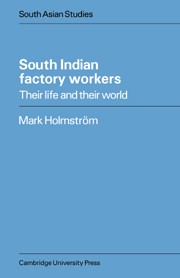1 - Introduction: the problems
Published online by Cambridge University Press: 06 October 2009
Summary
This book is a report on a short study of workers from four factories in Bangalore – an industrial city of some 1.7 million people – which I made in 1971. The study was designed to answer questions about the situation and thinking of workers in modern, capital-intensive factories, and to show how the methods of social anthropology can be used in the study of urban work, especially of new occupations in India.
It is based on case studies of workers and their families, also on statistical material from the managements' files on workers and from other sources, and interviews with managers and union officials. My justification for treating large-scale problems in a short study is that I spent fifteen months doing fieldwork in Bangalore in 1964–5, mainly among industrial workers, and I know the local background well; and that this is a pilot study in a field where there is plenty of research but not much of this kind. The conclusions need to be tested in more extensive studies of other workers, especially casual labourers and men who work in small workshops. Problems in the sociology of industrial India I made this study because of my interest in some questions in the sociology of industrial India, which have practical implications (though it is not my business – as a foreign observer – to suggest policies). Broadly speaking, these questions are about the social consequences of high-technology, capital-intensive industrialization and the conditions for it. There are large-scale consequences (for the country, and for those outside industry) and small-scale consequences (for industrial workers and their relatives).
- Type
- Chapter
- Information
- South Indian Factory WorkersTheir Life and their World, pp. 1 - 7Publisher: Cambridge University PressPrint publication year: 1976



